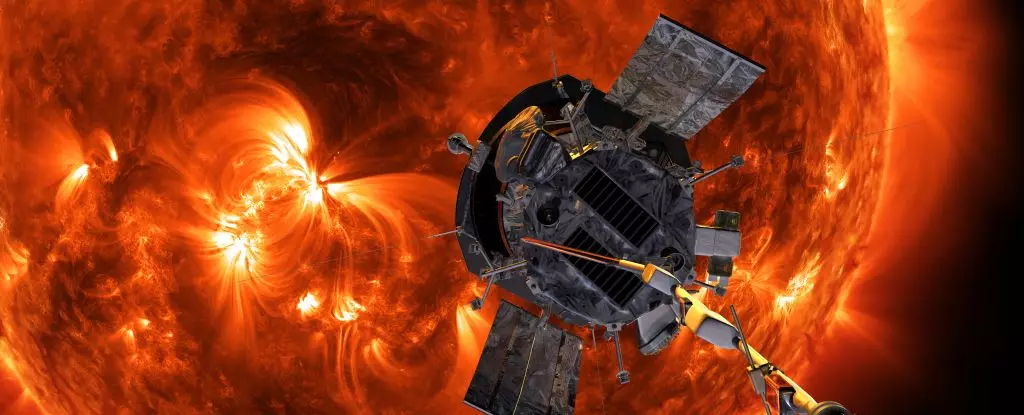The Parker Solar Probe is positioned to set a remarkable precedent in the realm of space exploration as it embarks on another daring journey to the sun. With an upcoming close flyby on Christmas Eve, this revolutionary spacecraft aims to surpass previous benchmarks, getting closer to the sun than any other human-made object in history. The implications of this mission extend far beyond mere distance; it represents a significant leap forward in our understanding of solar dynamics and astrophysics.
Scheduled for December 24 at 06:53 EST, Parker will skim a mere 6.1 million kilometers (approximately 3.8 million miles) from the sun’s surface. This proximity is not merely a technical milestone; it invites a plethora of scientific inquiries regarding the sun’s peculiarities. The spacecraft will race past at astonishing speeds of roughly 192 kilometers per second. Such speeds and distances redefine the possibilities of solar study, making Parker instrumental in answering questions that have puzzled astrophysicists for decades.
NASA has confirmed that the Parker Probe has successfully communicated its operational status, setting the stage for this high-stakes flyby. Following this mission, Parker is scheduled for further perihelion passes, each designed to yield critical data while remaining within a similarly extreme range. As noted by Arik Posner, program scientist for Parker Solar Probe at NASA, this mission embodies the spirit of human ingenuity. “This is one example of NASA’s bold missions, doing something that no one else has ever done before,” Posner said, emphasizing the exploration of unknown territories in our solar system.
Parker Solar Probe is not just a high-speed research vehicle; it is a key instrument in unraveling the mysteries surrounding our closest star. One pressing anomaly that researchers hope to decode is why the sun’s atmosphere, or corona, is significantly hotter than its visible surface, the photosphere. This critical temperature disparity remains one of the field’s prominent mysteries. Understanding this phenomenon could open new pathways to understanding solar dynamics and its broader implications for space weather phenomena that affect Earth.
Moreover, the generation of the sun’s magnetic field poses another conundrum that researchers seek to clarify. Questions remain about its source and behavior within the sun’s interior, where temperatures and pressures reach extremes beyond human comprehension. The data amassed by Parker during its close passes is anticipated to shed light on these complexities and contribute to our overall understanding of solar cycles, magnetic fields, and the sun’s evolutionary trajectory.
As Parker prepares for its historic approach, the scientific community eagerly anticipates the information that will emerge from this mission. Following the flyby, the probe will send a beacon signal on December 27 to relay its status, a crucial moment in the mission. “No human-made object has ever passed this close to a star,” says aerospace engineer Nick Pinkine, thus underscoring the groundbreaking nature of this endeavor.
In addition to the upcoming series of flybys planned through 2025, which will maintain the probe’s operational capabilities at similar altitudes and speeds, researchers understand the limitations of the technology involved. As the probe approaches its operational endpoint, the inevitability of resource depletion—specifically fuel for trajectory adjustments—poses a reality check for its numerous missions. Nonetheless, as Justin Kasper, principal investigator for Parker, informs, the finish will be grand. The ultimate demise of the probe will not merely signal an end but will culminate in a dramatic conclusion as it is propelled into the sun’s embrace.
In a world where technological advancements continue to push the boundaries of possibilities, the Parker Solar Probe stands as a testament to humankind’s quest for knowledge. Astrophysicist Nour Raouafi aptly likens this mission to the moon landing of 1969, underscoring its monumental significance in cosmic exploration. While we await the discovery of uncharted solar features and behavior, it is essential to recognize that this is not merely a mission for the present but a dive into the future of astrophysics.
As Parker Solar Probe prepares for its imminent flyby, it signifies not only a monumental accomplishment for NASA but a beacon of hope for global scientific advancement. Through this unique opportunity to study the sun up close, humanity continues its relentless pursuit of knowledge, reaching for the skies in a quest to unlock the universe’s many secrets.


Leave a Reply